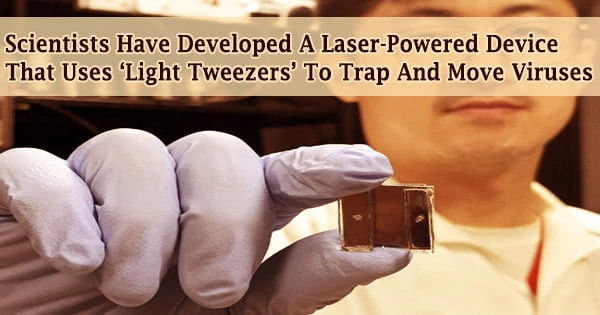A group of scientists lead by Nanyang Technological University, Singapore (NTU Singapore) has developed a laser-powered gadget that uses light to trap and transport viruses.
Because it can precisely’move’ a single virus to target a specific section of a cell, the device, which can manipulate light to behave as ‘tweezers,’ could contribute in the creation of new approaches to illness detection and virus research.
The technology would also help with vaccine development because it allows scientists to isolate damaged or incomplete viruses from a collection of thousands of other specimens in under one minute, compared to present techniques that are time-consuming and inaccurate, according to the researchers.
Associate Professor Eric Yap, from NTU’s Lee Kong Chian School of Medicine, a medical geneticist who co-led the research, said: “The conventional method of analyzing viruses today is to study a population of thousands or millions of viruses. We only know their average behavior as an entire population. With our laser-based technology, single viruses could be studied individually.”
“As well as diagnosing diseases, our device could be used to spot the outliers the rare individual virus that has the potential to evolve and create the next wave of an epidemic, for instance. This brings us into an era where we can contemplate precision diagnostics at the single virus level.”
The researchers used adenoviruses to test their gadget, known as a digital virus manipulation chip, which is a type of common viruses that can induce cold-like symptoms and have a diameter of 90 to 100 nanometres (nm). Although it has not yet been tested on coronaviruses, it has the potential to be employed in research on the SARS-CoV-2 virus, which produces COVID-19, due to its similar size of 80 to 120 nm.
The conventional method of analyzing viruses today is to study a population of thousands or millions of viruses. We only know their average behavior as an entire population. With our laser-based technology, single viruses could be studied individually.
Eric Yap
Professor Liu Aiqun, from NTU’s School of Electrical and Electronic Engineering, who led the research, said: “Our invention uses light to manipulate viruses in a certain size range and we have proven that it works with adenoviruses. We believe our device could also be used to trap and concentrate SARS-CoV-2 for research and diagnosis.”
In September, the study’s findings were published in the peer-reviewed scientific journal ACS Sensors.
The study also included researchers from Hong Kong Polytechnic University, the University of Hong Kong, the Hong Kong University of Science and Technology, the Agency for Science, Technology, and Research (A*STAR), the University of Technology Sydney, and the Australian National University.
The ‘light’ way to manipulating viruses with great precision
The gadget, which is roughly the size of a thumbnail and measures 2 cm by 2 cm, comprises of a chip built from silicon oxide and silicon nitride wafer with nanometre-sized chambers to contain the trapped viruses.
A laser sits above the chip, directing highly focused light beams with just the proper amount of energy to operate as ‘tweezers’ that isolate and transport viruses. The device functions by injecting a virus-containing fluid, such as blood, into the chip.
After then, a laser beam is focused on it, creating light spots. The virus is attracted to and trapped in predefined cavities on the chip because the intensity of the light is highest in the center of the spots.
Viruses can freely travel to other sections of the semiconductor by modifying the placement of the light spots. This facilitates the sorting and concentration of viruses ranging in size from 40 nm to 300 nm.
“Our invention is a breakthrough in virus research as it allows us to single out individual specimens for study, while comparable technologies today can only handle viruses in large quantities,” said Prof Liu.
“For example, we can isolate individual viruses with mutations to develop therapies against these variants. Our invention uses insulating materials that are biocompatible and do not heat up easily, unlike current sorting methods that generate a lot of heat. This means scientists should be confident in handling viruses with this device without affecting their properties and viability.”
Assoc Prof Yap added: “Using this technology, we could hand-pick specific virus particles and study them to gain novel insights into them and the diseases they cause. For example, it could open new channels for more detailed analysis of specific virus mutants, which could lead to new ways in characterizing and countering these viral variants.”
The researchers are attempting to broaden the application of their laser-powered device. They’re looking into how the device can instruct isolated viruses to infect a specific region of a human cell, for example.
According to the researchers, this will lead to advancements in virus research as well as increased efficiency in vaccination and antiviral medicine development.





